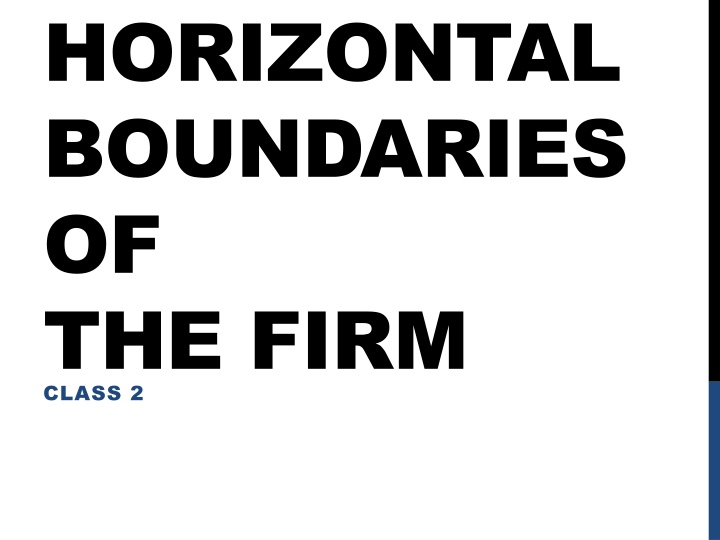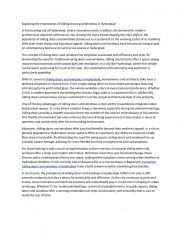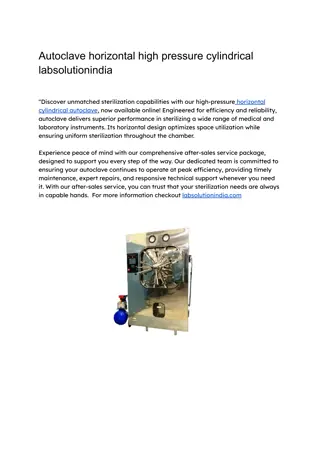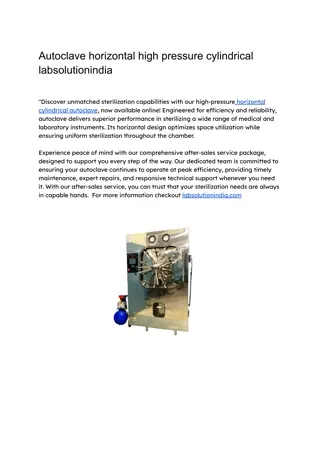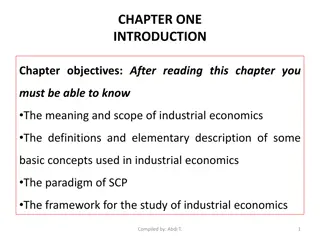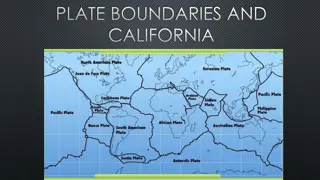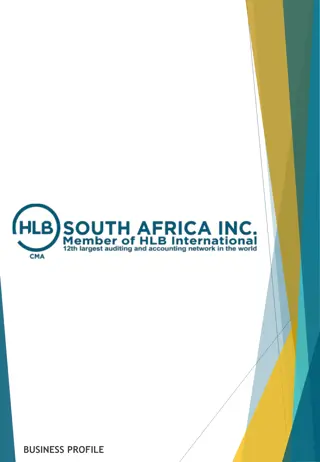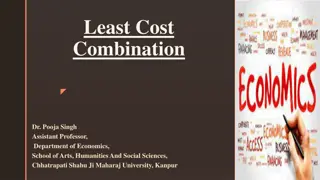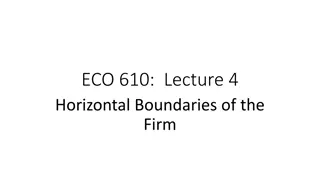Horizontal Boundaries in Firm Economics
Learn about horizontal boundaries, firm directions, economies of scale and scope, fixed costs, and a case study on water company operations. Dive into concepts of market reach, cost efficiencies, and natural monopolies.
Download Presentation

Please find below an Image/Link to download the presentation.
The content on the website is provided AS IS for your information and personal use only. It may not be sold, licensed, or shared on other websites without obtaining consent from the author.If you encounter any issues during the download, it is possible that the publisher has removed the file from their server.
You are allowed to download the files provided on this website for personal or commercial use, subject to the condition that they are used lawfully. All files are the property of their respective owners.
The content on the website is provided AS IS for your information and personal use only. It may not be sold, licensed, or shared on other websites without obtaining consent from the author.
E N D
Presentation Transcript
HORIZONTAL BOUNDARIES OF THE FIRM CLASS 2
DIRECTIONS OF THE FIRM oHorizontal oHow much of the market does the firm serve? oEssentially how big is the firm oVertical oRefer to a set of activities that the firm performs oAnd the activities that the firm purchases from specialty firms. oCorporate oA set of distinct businesses the firm competes in.
HORIZONTAL BOUNDARIES Two different elements to this Economies of Scale Economies of Scope Economies of Scale - A specific good or service exhibits economies of scale when average costs decline over a range of output. - If AC declines as output increase then the MC of the last unit must be less than the AC
ECONOMIES OF SCOPE -Economies of Scope exists if the firm achieves savings as it increases the variety of goods and services it produces. -TC(Qx,Qy) is the total cost to a single firm producing Qx units of good X and Qy units of good Y Examples Apples core competency is engineering allowing it to make ipads, iphones etc. TC(Qx,Qy) < TC(Qx,0) + TC(0, Qy) When managers say that firms should 1. Leverage Core Competencies 2. Compete on capabilities. They are essentially suggesting to exploit economies of scope. Ikeas core competency is product design which allows them to bring to the market a range of home furnishing products
FIXED COSTS AND INDIVISIBILITIES Spreading fixed costs over an ever greater volume of output Fixed costs arise when there are indivisibilities in the production process A delivery service will have to pay for a rider, the bike, petrol if the service is delivering one pizza or 20 pizzas. The above inputs represent indivisible fixed costs. Economies of Scale are related to specialization. To become specialists one needs to invest a substantial amount of resources. They won t invest if the market demand does not justify it.
CASE STUDY WATER COMPANY Tap Water High Fixed Costs of a national network. To produce tap water, the water companies had to invest in a huge network of water pipes stretching throughout the country. The fixed cost of this investment is very high. However, since they distribute water to over 25 million households it brings the average cost down. However, would it be worth another water company building another network of water pipes to compete with the existing company? No, because if they only got a small share of the market, the average cost would be very high and they would go out of business. This is an example of a natural monopoly most efficient number of firms is one. 1. Is the statement most efficient number of firms is one true? 2. Isn t competition good for the consumer? 3. What is to prevent the pipe company from increasing water charges?
SPECIAL SOURCES OF ECONOMIES OF SCALE AND SCOPE 1. Economics of Density 2. Purchasing 3. Advertising 4. Research and Development 5. Physical Properties of Production 6. Inventories
ECONOMICS OF DENSITY -Cost savings that arise within a transportation network due to a greater geographic density of customers. -Example What is most cost effective pizza delivery in Araganvila or Borella? - Cost savings can also occur by reducing the size of the area. Reducing transport costs whilst maintaining the same number of customers. PURCHASING -Bulk buying invariably leads to larger discounts (Purchasing power is high) -A supplier might not care if he is supplying 100 units to 1 customer or 10 units to 10 customers, why should you give you bulk discounts? 1. Less costly to sell to a single buyer (Contract costs, Delivery costs) 2. A bulk buyer is more price sensitive (Tenders, reducing cost per unit) 3. Supplier might fear disruption to operation, therefore having a big buyer that ensures production may assure steady flow of business.
ADVERTISING -National vs Local Advertising -Advertising bulk buying GroupM in Sri-Lanka -Advertising Reach and Umbrella branding Two companies spend the same amount on an advertising. One company is bigger. Who benefits more? Cost of sending a message / Number of Actual customer due to message Potential customers Potential customers receiving message receiving message RESEARCH AND DEVELOPMENT - Assume all firms spend 10% on R&D who is spending more? -Toyota spent almost $1 billion to develop the Prius -Drug companies must spend $500 million to successfully develop a new drug
PHYSICAL PROPERTIES OF PRODUCTION -Cube square rule https://www.youtube.com/watch?v=qoM17ikreio Basically when capacity increases the average cost of producing the capacity decreases. INVENTORIES -Why do companies carry inventories? -What are the costs associated with carrying inventories? -Inventory costs therefore drive up the costs of the goods that are actually sold.
SOURCES OF DISECONOMIES OF SCALE 1. Labour costs and firm size Larger firms pay higher wages and provide greater benefits Larger firms maybe more likely to be unionized Larger firms may have to recruit people from further (think Sri-Lankan garment factories) Spreading specialized resources too thin. Gordon Ramsey famous chef over expanded his restaurants and had to close down all except his best performing. He overextended himself and could not give his newer restaurants the same level of supervision. Bureaucracy Information flows might be slower in larger companies Incentives within larger firms can be muted 2. 3.
CASE STUDY - LOCKHEED A union contract required the company Lockheed to promote experienced line workers to management. This led to at least 10 workers getting promoted when one person got promoted to management. This resulted in a reduced labour productivity as the new workers had to relearn tasks already mastered by someone else. 1. 2. Was this a good policy to have, debate pros and cons What can be done to mitigate the losses to labour productivity. How would you promote people? 3.
THE LEARNING CURVE Economies of Scale refers to the ability to perform an activity at a lower unit cost when it is performed on a larger scale. Learning economies refer to reduction in unit costs due to accumulating experience over time. Therefore when larger companies start automating procedures having experienced people does not matter. Question year old doing their first job OR Someone who has been working in that position for 10 years? For a data entry position is it better for a company to have 19
DIVERSIFICATION -Diversification is costly -Diversification is generally difficult -Diversification may suffer from costs related to bureacracy If the above is true, why do firms diversify? Benefits >>> Costs 2 reasons why companies choose to diversify 1. May increase the efficiency of the firm. preference of the managers of the firm 2. Diversification decisions might reflect the
EFFICIENCY BASED REASONS Scope Economics what you distribute as long as it is profitable - If you are a distribution company you may not care you decide to import as long as there is a market - if you are an import company you may not care what Internal Capital Markets leverage for better profitability - Bigger firms have more money which will help them
MANAGEMENT BASED REASONS Benefits to Managers from Acquisitions - You can spread the risks package. - The larger the firm the bigger the compensation Problems of Corporate Governance appoint directors of their choosing. - CEO s can wield a lot of power, even as much as to information or may not care to stop diversification. - Shareholders of companies may not have
HOMEWORK EXERCISE For discussion in class 3, research the following information 1. 2 companies that have successfully diversified 2. 2 companies that have failed after diversification.
